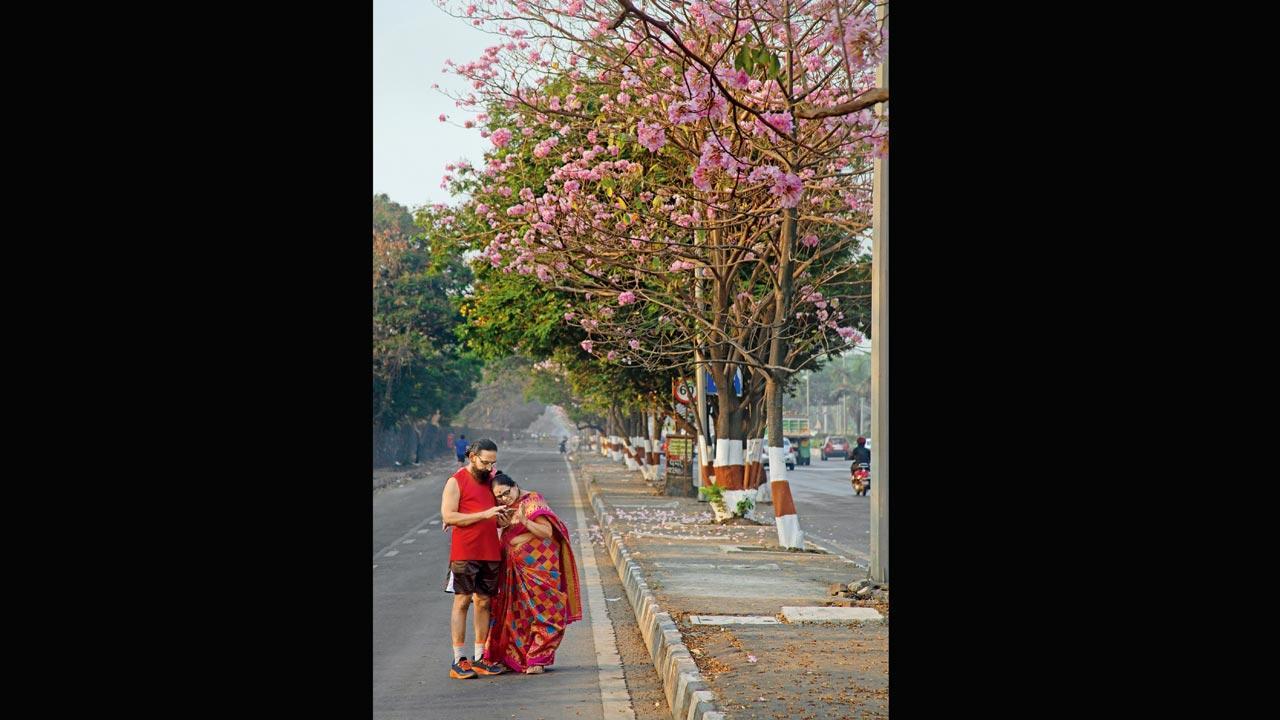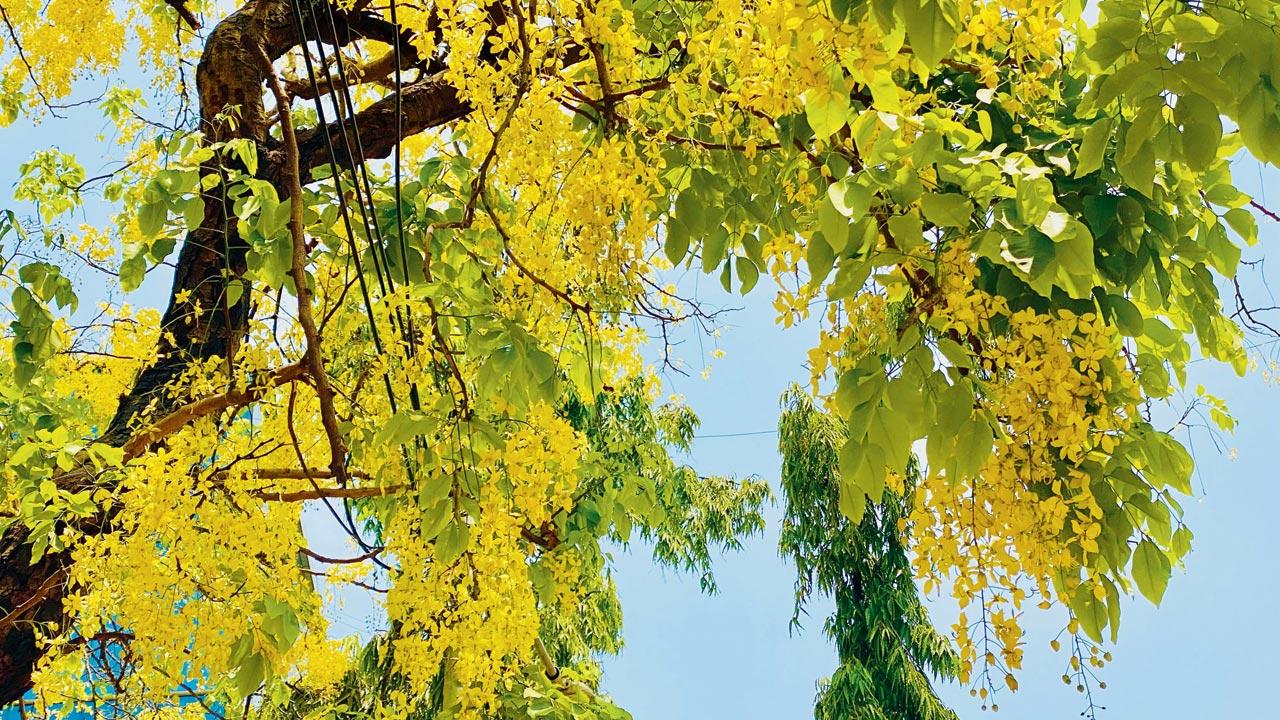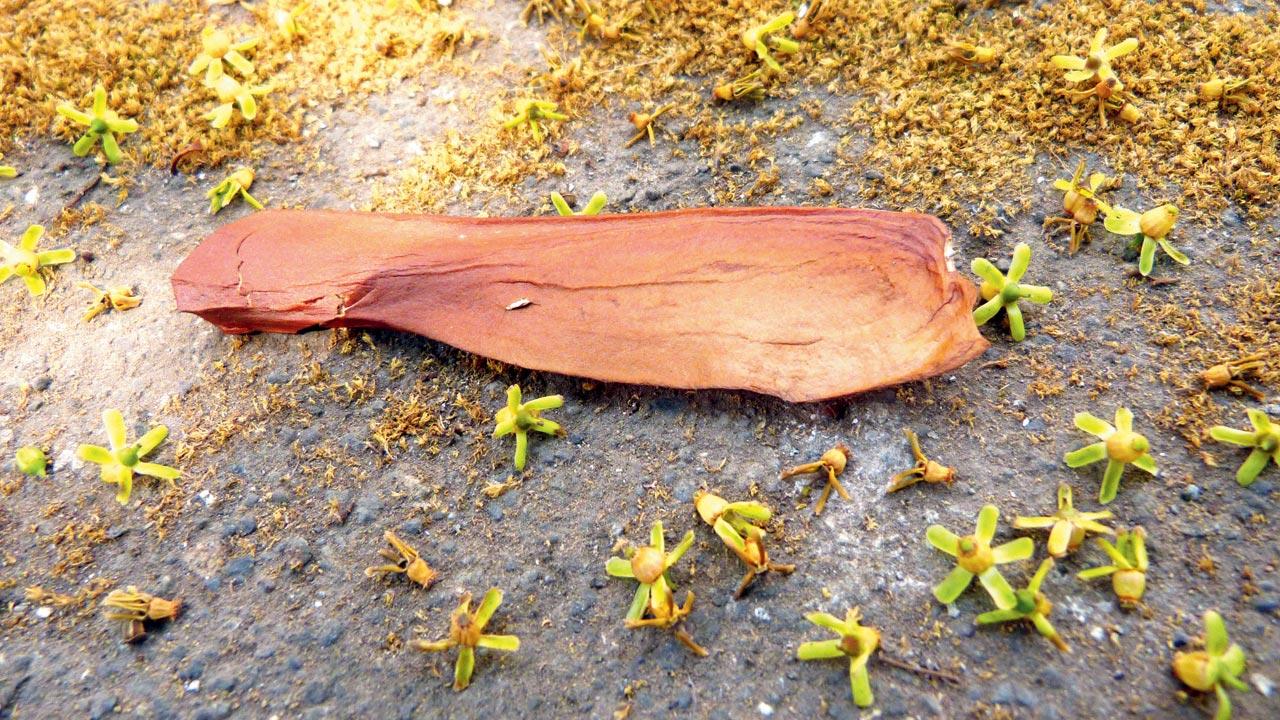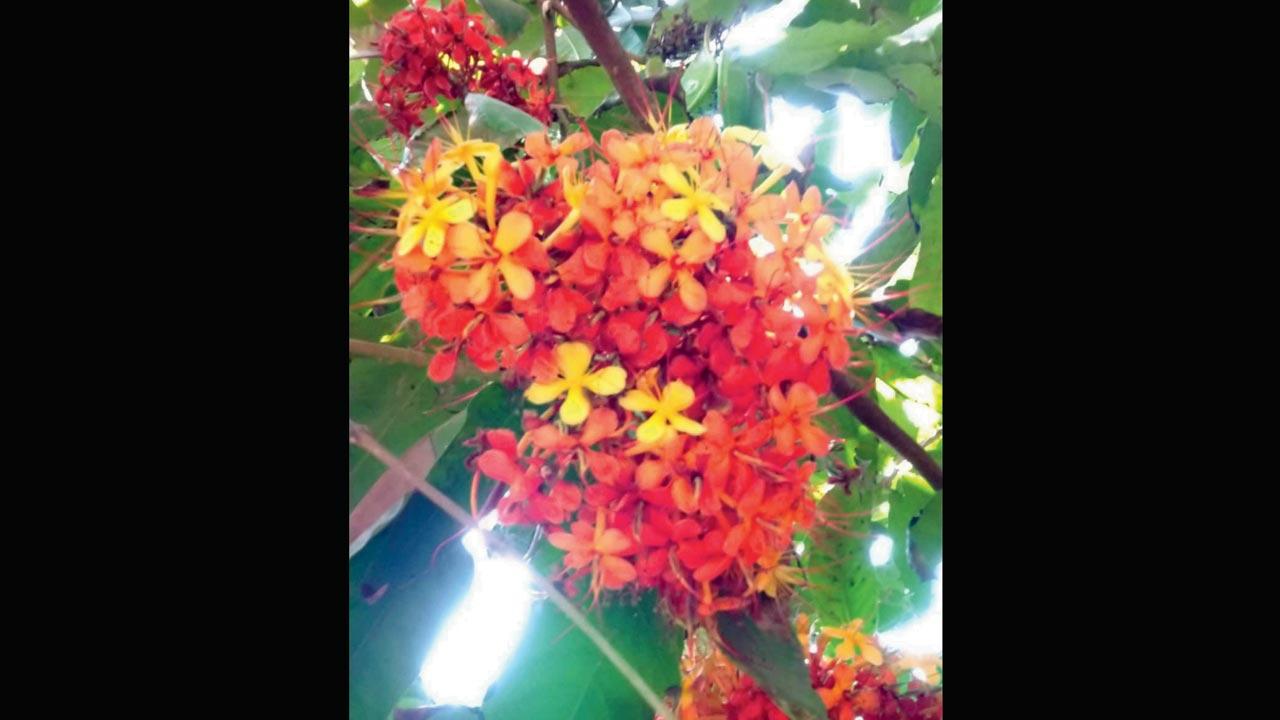As Bombay bids au revoir to dazzling summer flowers, nature lovers and photographers describe their favourite blooms

Tabebuia rosea greet morning walkers along the Eastern Express Highway’s Vikhroli stretch. Pic/Chirodeep Chaudhuri
 Strolling past hedges of Bandra cottages laden with vermilion gulmohar, burnished laburnum and pastel-perfect bougainvillea, even the beastly heat and dug earth at my feet seem less irksome. Dreamy clouds of peach mussaenda bushes sway enchantingly outside my window. It’s the time of year when Bombay is bedecked with the last beautiful summer blooms. Too bad these seasonal flowers will soon be swept away by gusty rain.
Strolling past hedges of Bandra cottages laden with vermilion gulmohar, burnished laburnum and pastel-perfect bougainvillea, even the beastly heat and dug earth at my feet seem less irksome. Dreamy clouds of peach mussaenda bushes sway enchantingly outside my window. It’s the time of year when Bombay is bedecked with the last beautiful summer blooms. Too bad these seasonal flowers will soon be swept away by gusty rain.
“Summer, to me, is synonymous with a profusion of golden blooms entirely covering the canopies of copper pod trees (Peltophorum pterocarpum) that are the cynosure of all eyes,” says naturalist and author Katie Bagli. “In Dadar Parsi Colony where the lanes are lined with these grand old trees, they seem to roll out golden yellow carpets under my feet. And in the evenings while I sit cooling my heels in one of the gardens, the blossoms come wafting down gently on my head and all around, like yellow snowflakes. Parakeets delight in plucking off these blossoms and sucking up their nectar, flower after flower. It amuses me no end to watch this little performance.”
 Flaming laburnum boughs shed to form yellow carpets on the ground. Pic/Sooraj Bishnoi
Flaming laburnum boughs shed to form yellow carpets on the ground. Pic/Sooraj Bishnoi
The gold canopies transform to coppery red owing to the copper-hued pods. This is how the tree got its name of copper pod. Closer observed, the flower shows its tiny stigma, flat as a shield and rust-coloured. This gives the tree its other moniker: Rusty shield bearer. Among the variety of birds that haunt the copper pod branches—including cuckoos, bulbuls, sunbirds and sparrows—is, coincidentally, the coppersmith barbet. Its cry does sound exactly like a coppersmith beating a sheet of copper.
But the copper pod is Bagli’s second favourite. Her first is the imposingly handsome mahogany. “Beginning in spring and moving on into summer, the avenue of mahogany trees (Swietenia mahogani) in the colony puts on a fashion show of sorts. First, they shed all their dried leaves, which the poor BMC sweepers have a hard task clearing piles of in the morning. The massive canopies soon adorn a brand-new garment of pretty, pinkish leaves that turn fluorescent green.”
 The massive mahogany sprouts delicate fluorescent green flowers. Pic/Katie Bagli
The massive mahogany sprouts delicate fluorescent green flowers. Pic/Katie Bagli
A couple of weeks later the trees begin showering in profusion, miniscule flowers that look like ear studs and lend a delicate fragrance, making morning walks sheer joy. Pavements and parked cars are sheathed by them, as if saluting the advent of summer. “Spend a few moments staring intently and you may see seeds attached to propeller-like wings twirling their way to the ground,” Bagli says. “Don’t miss the round, woody pods from where they are dispersed. The mahogany is a real marvel of nature. Its tiny, delicate flowers give rise to tough capsules containing scores of seeds that sprout gigantic trees.”
At the east end of Rampart Row (K Dubash Marg) in Kala Ghoda, stands possibly the city’s oldest, majestic mahogany. Fronting Ador House, sentinel-like, it is one of a pair planted by the missionary explorer Dr David Livingstone himself. The other borders the Bombay Natural History Society’s headquarters, Hornbill House, named after William the hornbill, who fluttered into this garden and stayed on to reign as the BNHS mascot. Sailing in on the Lady Nyassa for a spell of six months in 1865, Livingstone planted the pinnate-leafed mahoganies at the behest of Governor Bartle Frere. Foreign dignitaries who visited the city, from Chou En Lai to Josip Broz Tito and Nikita Khrushchev were encouraged to sow trees.
 Colourful bloom clusters adorn the Sita Ashok tree. Pic/Kitayun Rustom
Colourful bloom clusters adorn the Sita Ashok tree. Pic/Kitayun Rustom
Photographer Chirodeep Chaudhuri’s vote goes to Bombay’s own “cherry blossom” (as the rosy trumpet tree is referred to in common parlance), which has already shed most of its gorgeous spring blooms. The emotions evoked by Tabebuia rosea—one among 109 species of its genus lining the Vikhroli belt of the Eastern Express Highway—make them more appealing for Chaudhuri, who loves the months that splash the city pink, thanks to these flowers and the flamingos of Navi Mumbai.
“I find this interesting because the colour I most connect with the city is grey, those wonderful dark shades of clouds during the monsoon, but depressing when the air hangs with smog on most days,” says Chaudhuri. “Commuting by train for many years, I had never experienced this stretch of the highway. Now I occasionally use the car and each time find myself excitedly waiting for that bit of the road. I tell the driver to slow down to prolong that feeling.”
Nature lover and photographer Sooraj Bishnoi was a puzzled kid when he first spied a summer-kissed laburnum in Khar. “I was mystified by what I thought were long bunches of bright yellow grapes hanging from the tree. Observing the fallen flowers on the ground, I realised these weren’t fruit. After that, I went laburnum-spotting in summer, to find these trees in full bloom across the city. A laburnum in bloom today still takes my breath away. The sight of the ‘yellow grape flowers’, as I called them in my childhood, always puts a smile on my face, bringing back warm memories of vacations, playing with friends and exploring the city—all the while being greeted by these dancing bunches of yellow flowers of the Cassia fistula and skipping around on its consequent yellow carpets below.”
Bishnoi shares that the Indian laburnum, or amaltas, occupies a special place in Indian culture. Associated with Vishnu worship, it is used as well in Ayurvedic medicine as an “aragvadha” or “disease killer”. A folk narrative has it that the flowering of the laburnum, sometimes called golden shower or pudding-pipe tree, marks the start of a 60-day countdown to the onset of the monsoon.
A charming allusion to Laburnum Road and a pair of parallel paths is printed in Samuel T Sheppard’s seminal 1917-published work, Bombay Place names and Street names: An Excursion into the By-ways of the History of Bombay City: “There is Alexandra Road, one of a little group in Gamdevi which owe their names to the species of tree planted along them by the Improvement Trust. Laburnum Road, Alexandra Road, Cirrus Avenue. Everyone knows a Laburnum in flower, but the writer will not be alone in confessing that he has no idea what a Cirrus or Alexandra look like. The Queen Mother will, of course, be thought to be the Alexandra referred to, whereas she is presumably godmother to the tree and gives her name by that indirect method to the road.”
The Indophile editor Sir Stanley Reed said in a 1920s public address: “The palms of Gamdevi have given place to the flat-bordered Hughes Road where gold mohurs and peltophorums are splendid in May. I rejoice that one of the side roads radiating from it bears the appropriate name of Laburnum Avenue.”
A road that presents the barest traces of the botany it is rooted in, is Tamarind Lane, owing its origin to a tree near St Thomas’ Cathedral. This was located at the edge of the old Cotton Green, where it was customary for traders to hold auctions. Traders would promise to meet “aamli aagal”—in front of the tamarind tree—which, the Bombay Gazetteer tells us, fell in November 1846. A solitary such tree, with flowers formed of red and yellow elongated petals, now shades the north-east corner of the cathedral compound.
Believing that every tree tells a tender story, environmental educationist Kitayun Rustom says, “I love tales associated with the Sita Ashok (Saraca asoka) tree, also known as ‘True Ashok’. In Sanskrit, Ashok means ‘without grief’. The tree is often described as Sorrowless Tree because Hanuman found Sita under it. The moment she saw him, Sita realised she would soon be rescued from Ravan’s clutches.”
This tree is clad in rather unusual leaves and flowers. Soft new leaves drooping in hues of red, pink and limpid green traditionally play an important role in Buddhist and Hindu rituals. Likewise, its inflorescence is unique. Yellow when young, the flowers change to vivid orange and then crimson on maturity, looking striking against the dark green backdrop of the leaves, like posies. Long stamens give them a hairy appearance which adds to their overall brilliance.
“It’s heavenly to just soak in the bliss from this tree,” says Rustom, who much enjoys her time wandering beneath the Sita Ashoks in Kamala Nehru Park. “Each has a particular power, passing on certain energies to you. To seek happiness, sit or sleep under a Sita Ashok. Imbibe the infinite peace, celebrate the qualities it can fill your life with. And if you can’t find a tree, you must grow one.”
Author-publisher Meher Marfatia writes fortnightly on everything that makes her love Mumbai and adore Bombay. You can reach her at meher.marfatia@mid-day.com/www.meher marfatia.com
 Subscribe today by clicking the link and stay updated with the latest news!" Click here!
Subscribe today by clicking the link and stay updated with the latest news!" Click here!










